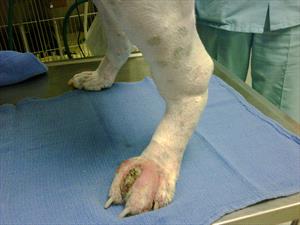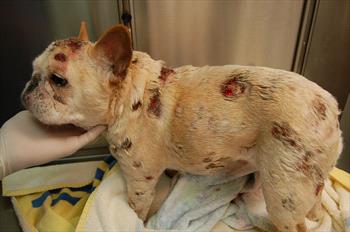Epitheliotropic lymphoma

Epitheliotropic lymphoma affects both back feet of this boxer. Photo Courtesy of Dr. Jeff Chemelewski
(also known as cutaneous T cell lymphoma and cutaneous epitheliotropic lymphoma)
Lymphoma can arise in any organ that contains lymph tissue (which turns out to be just about anywhere in the body). While lymphoma generally occurs in lymph nodes and organs with substantial lymphatic system presence, occasionally, lymphoma arises in the skin. Skin forms of lymphoma are often itchy and rashy and thus are readily mistaken for allergic dermatitis. Further compounding the difficulty in making the correct diagnosis is the fact that superficial skin infections are common not only in allergy situations but in many skin diseases, including skin lymphoma, so partial responses to antibiotics may be misleading. Lymphoma in the skin would be a rare cause of dermatitis, but there comes a point where a biopsy is needed to explain a poor response to the usual therapies. A biopsy is needed to capture the diagnosis of lymphoma.
Three Types
There are three types: mycosis fungoides, Sézary syndrome, and pagetoid reticulosis.
Mycosis Fungoides
The name "mycosis fungoides" suggests a benign fungal infection, but nothing could be farther from the truth. Mycosis fungoides is a very malignant form of skin lymphoma; it is named for fungus because the tumors are said to resemble mushrooms.
An oral form also exists where the gums become inflamed and ulcerated. This could also be mistaken for any number of oral diseases, and again, a biopsy is needed to find the truth. As mentioned, it can look like a skin infection with nodules and frequently goes unrecognized until it fails to respond to the usual skin-oriented antibiotics and is biopsied.
Sézary Syndrome (A Rare Complication)
Mycosis fungoides can progress to what is called Sézary syndrome. Here, skin cancer advances into the bloodstream to create leukemia. The cancer cells in the blood are not like other leukemia cells and are called Sézary cells. This complication almost never happens in dogs but happens in approximately 5 percent of humans with mycosis fungoides, so the term may come up if you do any internet research.
Pagetoid Reticulosis
The only difference between pagetoid reticulosis and mycosis fungoides is seen on biopsy. Pagetoid reticulosis is a more superficial form of skin lymphoma that does not penetrate to deeper skin structures. It can be localized to one area of the skin or to larger areas of the skin.
Prognosis
Most pets succumb to euthanasia when there are too many ulcerated growths, too much intractable itching, or the infections cannot be controlled. Variable survival times have been reported in different studies, but the prognosis is generally regarded as poor, while a good goal is six months for dogs and perhaps 10 months for cats. (This contrasts with the human form of the disease, which is much more readily controlled with chemotherapy.) For many patients, the goal of chemotherapy is not to achieve a longer survival but to improve life quality during a relatively short survival. Most studies report median survival times of 6-7 months.
Epitheliotropic Lymphoma, Dog (Photograph)

Epitheliotropic lymphoma in a French bulldog. Photo Courtesy of Dr. Neal Saslow.
Treatments
Since most tumors arise in groups or involve large areas, surgery or radiotherapy will not be effective. Chemotherapy will be needed to reach all the tumors. This might be provided by a single medication like lomustine but could just as likely include a multi-drug combination protocol involving such medications as L-asparaginase, prednisolone, cyclophosphamide, vincristine, and/or doxorubicin.
Aside from chemotherapy regimens, a few less conventional methods have emerged.
Retinoids
Skin lymphoma cells appear to have receptors for synthetic vitamin A derivatives. Median survival times have been increased with retinoids. This all sounds good, but the type of retinoids used to treat such skin diseases also cause human birth defects, and because of this, their access is highly regulated, and they are very difficult to obtain in the U.S.
Safflower Oil
The Hollywood brand of safflower oil (apparently, the Hain brand does not work) was given to six out of eight dogs who had lost remission from conventional treatment and were able to achieve remission with no other therapy. It should be noted that this was a very small study (only eight dogs), and GI upset can result from the twice-weekly oil doses needed for this therapy.
Rabacfosadine
This is a new medication recently approved for lymphoma treatment in dogs. When combined with prednisolone, 45 percent of dogs with this condition achieved at least partial remission.